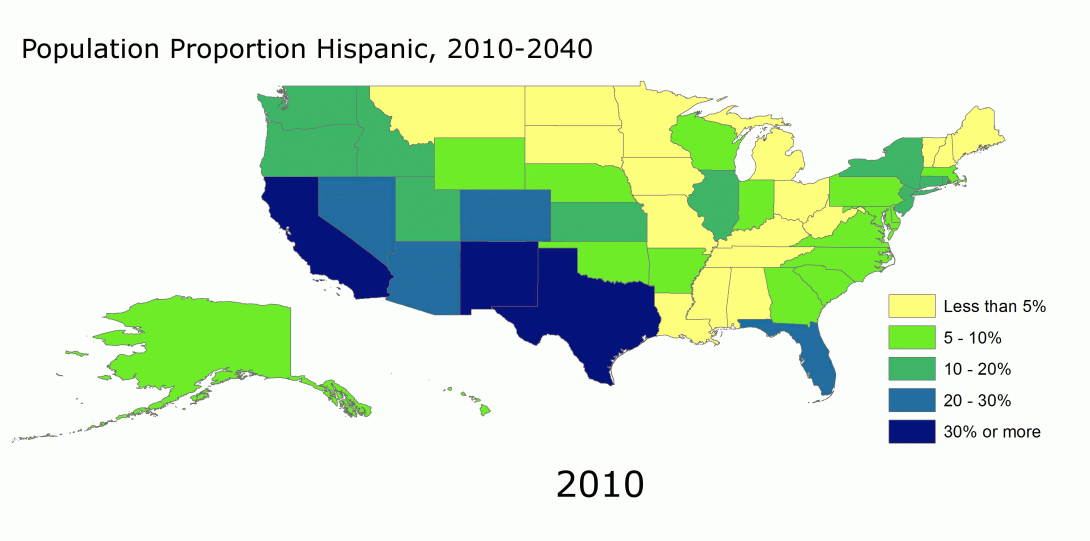What we can learn from national projections
We released today population projections for the nation overall and for all 50 states (and the District of Columbia). These are the first projections to be produced using data from the 2010 Census, and they detail changes between 2020 and 2040 in overall population and in subgroups by age, sex, race, and Hispanic origin.
While many states develop state-specific projections for use in state and local-level planning, our approach applied the same methodology to all 50 state projections, allowing for a fresh analysis of how the demographics of the nation, and each of the states and D.C., may look in the future. Population trends, such as population aging and increasing diversity, are not experienced evenly across all states, and using a consistent methodology allows us to highlight variations at the state level that are missed in national-level projections.
Population Growth and the Rise of the South
The U.S. population as a whole is projected to reach 382 million by 2040. While most states are also projected to continue growing, this is not the case for all states. West Virginia is projected to steadily lose population each decade for the next 30 years. North Dakota and Iowa are projected to hit peak total population in 2030, and then experience slight declines in total population between 2030 and 2040.
The 5 most populous states in 2010—California, Texas, New York, Florida, and Illinois – will still be the largest states in 2040. Between 2010 and 2020, however, Florida is projected to surpass New York in population to become the 3rd largest state in the nation.

Other large Southern states are also projected to make large real and relative gains in population in the coming decades. Between 2010 and 2040, Georgia is projected to go from the 9th most populous state to the 6th most populous, North Carolina is projected to rise from 10th to 8th, and Virginia is projected to rise from 12th to 10th in overall population. Consequently, we should expect the South, already the most populous region in the United States, to increase in influence, both politically and economically, in the coming decades.
Population Aging
We have long anticipated the impact of the Baby Boomers on population aging, but what was once in the future is now a reality. The proportion of the population that is 65 and older is projected to grow steadily over the coming two decades, peaking in 2030 and then plateauing or declining slightly in most states thereafter. Yet, in multiple New England states, the older population will become and remain a significant proportion of state residents. Nationally, 18% of individuals are projected to be 65 or older by 2030; these proportions are projected to be substantially higher in Maine (27%), Vermont (25%) and New Hampshire (24%). These high proportions reflect the aging-in-place of large populations of individuals currently between the ages of 45 and 64, as well as lower levels of in-migration of younger people.
Increasing Diversity
The projections also reveal that the nation will continue to grow more diverse. The proportion of white Americans is expected to decline, while the category of “other race” (which includes races other than white alone, black alone, and Asian alone) is projected to grow substantially. This is due to increases in multi-racial identification, interracial marriage and childbearing, and the growing Hispanic population (which tends to split racial identification between “white” and “other race”). In some states, such as Illinois and New York, the “other race” category is projected to surpass black or African-American as the largest minority group by 2040.

The Hispanic population is also projected to grow over the next 30 years, driven by both continued immigration and high levels of childbearing (reflecting, in part, the greater proportion of Hispanics of child-bearing age compared to non-Hispanic populations). California, Texas, and New Mexico – three states with large Hispanic populations – are projected to become majority Hispanic by 2040.
The Takeaway
In many respects, the results of the projections are unsurprising: they reflect current population structures and a continuation of well-established trends. The impact of the large Baby Boomer cohort on population age structure has long been anticipated, for example, and we can expect immigration and births to continue to contribute to population growth, albeit at a slower pace than at their height in the mid-2000s. Of course, projections are not prophecies, and the future is inherently hard to predict. But while we may not know what 2040 will bring with certainty, by using a consistent methodology to project the population of all 50 states, we can better understand how demographic drivers affect states differently.
Read more about the methodology and download the data at our National Population Projections page.


